Okay okay, you've read that far. You really might be the person who might save me from the wrath of the gods.
I have, in the last several years been able to deduce certain values needed to solve the problem at hand. Reminder: We are trying to plot and simulate the orbits of all the planets in my current solar system.
These are all the values I have worked so hard to obtain.
| Semimajor axis (in AU) | Eccentricity (AU) | Initial orbital angle (rad) | |
|---|---|---|---|
| Planet 0 |
0.299162 |
0.00455598 | 0.0 |
| Planet 1 | 0.436008 | 0.01880669 | 0.80918826 |
| Planet 2 | 1.74548 | 0.07247436 | 2.44577093 |
| Planet 3 | 2.57774 | 0.06907889 | 4.56681552 |
| Planet 4 | 0.117936 | 0.06678809 | 2.77070049 |
| Planet 5 | 0.656736 | 0.02808009 | 0.83867168 |
| Planet 6 | 1.00059 | 0.0208496 | 3.85528412 |
| Planet 7 | 3.42128 | 0.02958261 | 1.3639456 |
Using this data I've devised a simulator to help us solve this easily. Given that you have been introduced to programming in your mathematics and physics classes, I will not explain programming basics.
The function takes the planet number, and the amount of N points I want to calculate. N-points are the amount of points I will be calculating the values for, so If we take 1000 points between 0 and \(2\pi\) we will have 1000 equally spaced points between 0 and \(2\pi\). Inside of the function we will retrieve the data of the planets found on the table above and then insert in the equation \(r = \frac{a(1-e^2)}{1+e \cos f}\) , however this expression gives us values for the position of the planet in polar coordinates, so we would have to convert them to the conventional x,y coordinates.
Polar coordinates are just another way of describing where a point is or how a vector looks. We use the angle \(\theta\) and line length \(r\). Think of the x,y coordinate system, but instead of going (1,1) one step right and one up, you go \((\frac{\pi}{4},\sqrt 2)\) an angle \(\pi \over 4\) from the x-axis anti-clockwise and where that angle stops you draw a line with length \(\sqrt 2\) . Try locating these two points on the same graph. They should be the exact same point, described in different ways.
This is important because we will be shifting our answer that is in polar coordinates to normal x,y coordinates. (put figure here that shows basic trig). In the figure above you see the expression for x, can you find an expression for y? Yep, it's the exact same, just with sin instead of cos. We will do the exact same here, our answer will be given as \(r(\theta)\) and we'll convert that using \(x = r\cos \theta \) and \(y = r \sin \theta\)
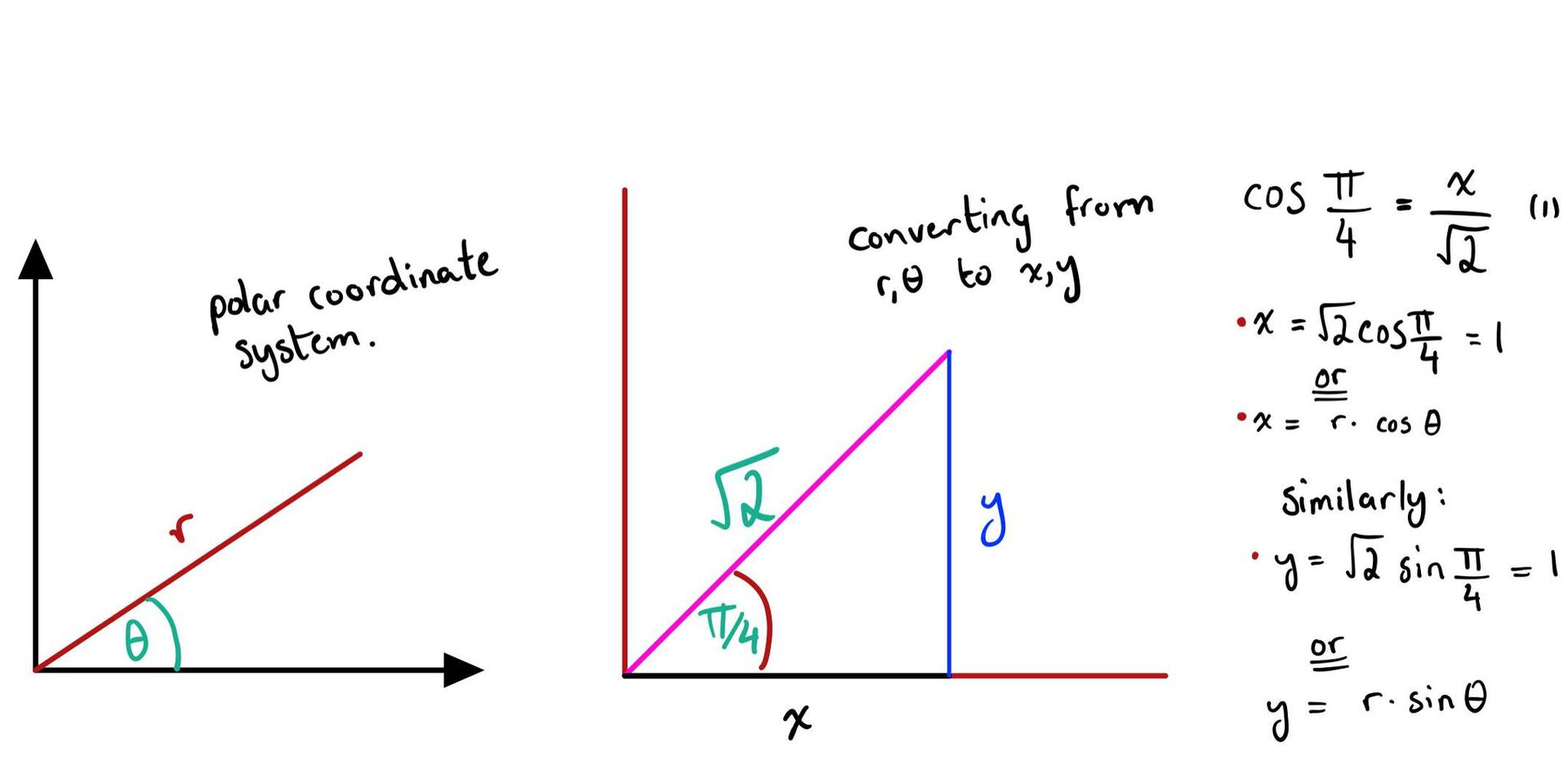
Now we have everything we need, let's do this and look at the results!!

This figure is pretty self explanatory, it's just planets orbiting the sun. A few things to note, the orbits are as we have predicted, ellipses. And the semimajor axis of the planet I currently am on (planet 0 in blue) , is around 0.15 AU wide, your planet earth is 1.0 AU , good thing my sun is not too hot.
We can also interpret the results a bit more with some more knowledge that you have learned in your class, Kepler's laws. Kepler's third law states that the period (in years) around the sun is given by \(P ^2= a^3\) where a is the semimajor axis in AU. Now Kepler did his best with the data he had, and at the time the observations weren't all that accurate BUT his law was kind of wrong, wrong law if you will. Newton derived the period from basic principles not from observations, which means his is more accurate. This is how Newton formulated it \(P ^2 = \dfrac{a^3}{(m_1 + m_2)}\) if we use the gravitational constant in astronomical units instead of SI. Let's use it to find out how long it takes for my home planet to go around my sun. Inserting for all the values i get
\(P^2 = \dfrac{ 0.29^3 AU}{(8.42 \cdot 10^{-6}M_\odot +0.65 \,M_\odot)}\) I have approximated the numbers in view here but I will use the full numbers when I do the calculation. Also that funky M is just the unit solar mass. Anyway, the final answer is approximately 0.19 years to do a full 360 around my sun!! Pretty short huh? That's 69 days. However, my sleep cycle hasn't changed much, I sleep pretty much like you do, but I predict that within 1300 years (if this mission doesn't succeed) I will adjust my circadian rhythm to this planet.
It is time to simulate our numerical orbits, don't remember exactly what the procedure was and the motivation behind it? Check this out before you continue. Here are the results. The simulation goes through 10 earth years.
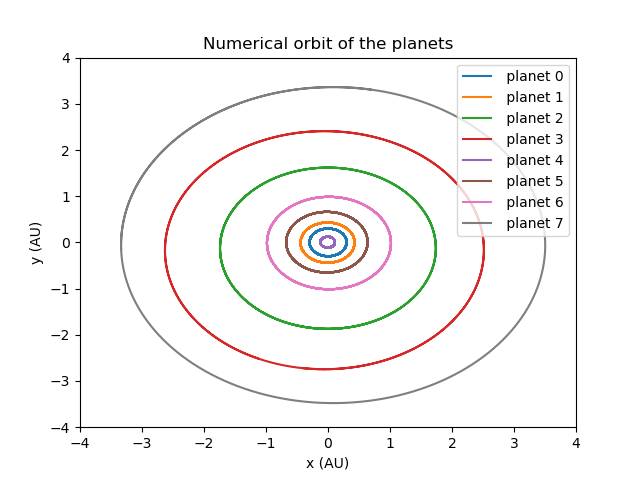
Let's analyze this a bit and see if the simulation makes any sense. First of all, the orbits are all elliptical but are they the correct ellipses? What we can do is use the data that I am certain is true, and compare it with the data we get from the plots. We know that the semi-major axis is supposed to be around 0.30 AU, to make it easier to see I will simulate my planet alone.
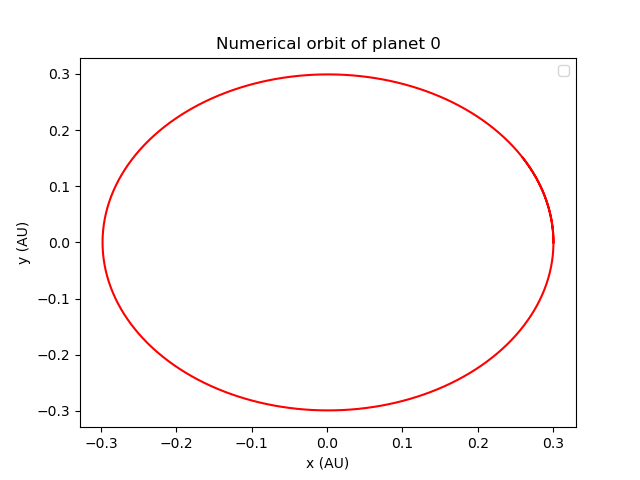
Here we see that the width from the center of the ellipse to one of the sides is approximately 0.30 AU, remember that our simulator does not know how large the semi-major axis is supposed to be. Another test we can do is use the period we found above, namely that it takes 0.19 years to go one full rotation around the star. We can model 0.15 years which is three fourths of 0.20 years to see if the orbit will only be three fourths of a full ellipse.
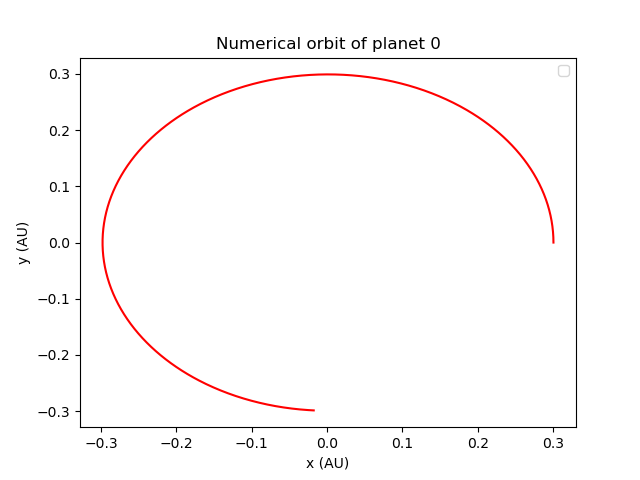
Sweet, now the final challenge is to simulate both the numerical and the analytical simulations on the same plot and see if they are identical.
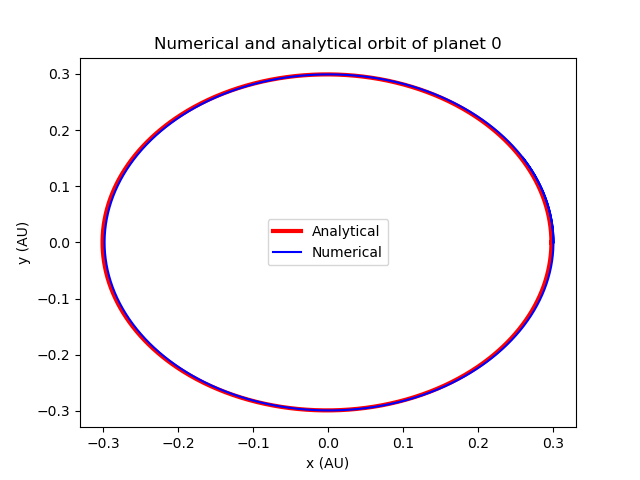
At first glance they seem to be identical, but if we look closer at the left side we see that the blue line is on the inside of the ellipse made by the red line but on the ride side we see that the blue line is outside of the ellipse. This might not be so large of a difference but this is one of the closest planets, so we must model all of the planets and see if this persists.
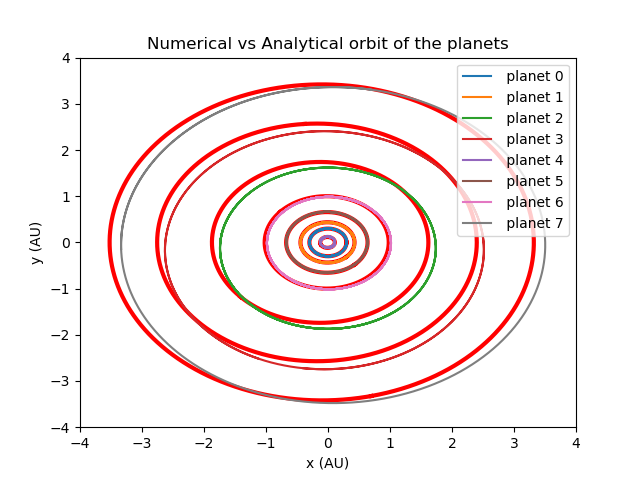
AHA! Now we see it much more clear, there is inconsistency but I can't help but notice that the total area of the ellipse seems to be identical. If you can't see it here's a figure that should help you see it. Look at the area marked in black, do you agree that it is equal?
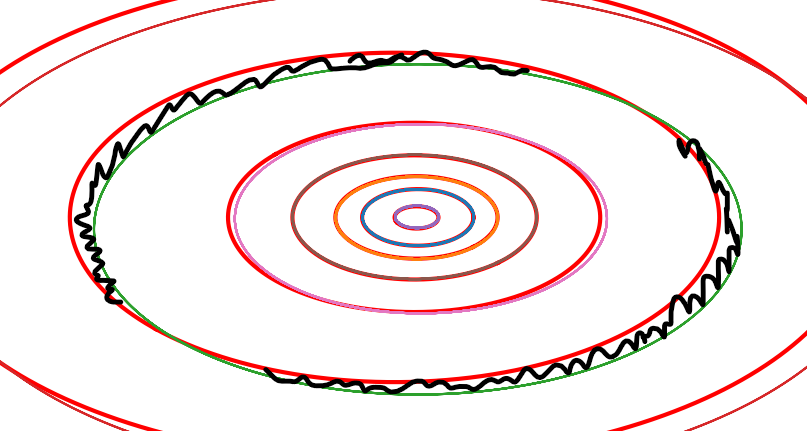
Note that this plot has been stretched to show an exaggerated effect! Hmmm. What could be causing them to be identical but not aligned? I think that one explanation could be that the angle is different, like one is more tilted than the other one, I will not go into further detail to fix this error, it is enough for my needs as I'm not sure how to fix this error.
These results might be sufficiently accurate but they are not accurate, I have reduced the number of time steps just so that my simulator does not take 6 months to run, more time steps means more time taken to run the simulation, although I do think that it is sufficiently accurate because the plots are smooth and my planet orbited my sun 20 times, more time steps after this might not show much difference. (Diminishing returns)
In addition: To spare myself some years I have made some hefty assumptions. Here is the list:
- I ignored planet-planet interactions and only considered the gravitational pull on the planets by the star.
- I ignored relativistic effects.
- I ignored the gravitational pull on the star by the planets. I assumed that the star is fixed at the origin throughout the simulation.
- I assumed that all orbits exist in the same xy-plane. I ignored the z-axis.
- I ignored all other astronomical bodies in the solar system, including moons.
You might be protesting: "Did this guy even do anything? Why not assume the whole problem away?" but you have to hear me out, the simplifications have an impact but not aaaaaaaaaaaall that big. Let me make my case. The most grievous of the assumptions is the planet-planet interaction. The thing is, there is some accuracy lost here, but it's not all that much, the reason being that the attraction from the sun dwarfs every other force in magnitude. We can look at the earth and other planets to illustrate this point.

Column D is the important piece of information to look for (in case you didn't know e-7 is \(\cdot 10 ^{-7}\)), it is the maximum acceleration between an astronomical body and earth, why is it maximum? Because the distance always changes given that the astronomical bodies are in orbit themselves around the sun. So if you compare the pull from the sun on your planet to pull from other planets you see that the closest one is Venus which is 1000 times small than that of the sun, plus the distance between earth and other planets drastically changes during the orbit.
That is not to say that we don't lose accuracy, we definitely do lose some accuracy at the moments where our planet is at its closest to another massive planet, but it will not be as large. We lose a lot more accuracy when we ignore moons, the second strongest force on earth is from the moon, even though it's not very large, it's very close, force is proportional to distance squared but only proportional to mass (not squared or anything).
Relativistic effects can be safely ignored since we are nowhere near the speed of light, for example earth has orbital speed 107,000 km/h (source). All relativistic effects can be ignored as long as the Lorentz factor is sufficiently close to 1, Lorentz factor is given by \(\gamma = \frac{1}{\sqrt (1 - v^2 / c^2)}\), so inserting 107,000 km/h in this equation i get 1.00000000491693733705, 0.00000000491693733705 is the difference in effect, we can ignore this and barely lose any accuracy.
The pull on the sun by other planets is similar to the argument I made for planet-planet collisions. My sun is so large and massive, and the pull is directed from different (sometimes opposite) directions that sometimes cancel out. So the sun is unfazed by all these force, mainly because it is so massive. For example, in your solar system the sun accounts for 99.8% of all the mass! (source). I wouldn't be surprised if the mass center between the sun and all the other planets is within the sun itself, if we use point masses that is.
Does this stuff not make sense? You want to see more data and numbers instead of qualitative approaches? Join me here to check quantitatively how accurate my orbits are.